fuse box TOYOTA MIRAI 2020 Owners Manual (in English)
[x] Cancel search | Manufacturer: TOYOTA, Model Year: 2020, Model line: MIRAI, Model: TOYOTA MIRAI 2020Pages: 528, PDF Size: 11.98 MB
Page 4 of 528

TABLE OF CONTENTS4
MIRAI_OM_USA_OM62073U6-1. Using the air conditioning
system and defogger
Automatic air conditioning system............................. 306
Heated steering wheel/ seat heaters .................... 315
6-2. Using the interior lights Interior lights list ................ 317• Interior lights ................. 318
• Personal lights .............. 318
6-3. Using the storage features List of storage features...... 320• Glove box...................... 321
• Console box .................. 321
• Cup holders .................. 322
• Bottle holders ................ 324
• Auxiliary box ................. 324
Trunk features ................... 325
6-4. Other interior features Other interior features ....... 327• Sun visors ..................... 327
• Vanity mirrors................ 327
• Clock ............................. 328
• Armrest ......................... 329
• Coat hooks.................... 329
• Assist grips ................... 330
• Power outlet .................. 331
• USB charging ports....... 332
• Wireless charger ........... 334
Garage door opener .......... 343 7-1. Maintenance and care
Cleaning and protecting the vehicle exterior .......... 352
Cleaning and protecting the vehicle interior ........... 356
7-2. Maintenance Maintenance requirements ................... 359
General maintenance ........ 361
7-3. Do-it-yourself maintenance
Do-it-yourself service precautions ...................... 364
Hood .................................. 366
Positioning a floor jack....... 367
Motor compartment ........... 369
12-volt battery .................... 374
Tires................................... 378
Replacing the tire............... 386
Tire inflation pressure ........ 393
Wheels............................... 396
Air conditioning filter .......... 398
Electronic key battery ........ 400
Checking and replacing fuses ................................ 402
Light bulbs ......................... 405
6Interior features7Maintenance and care
Page 369 of 528
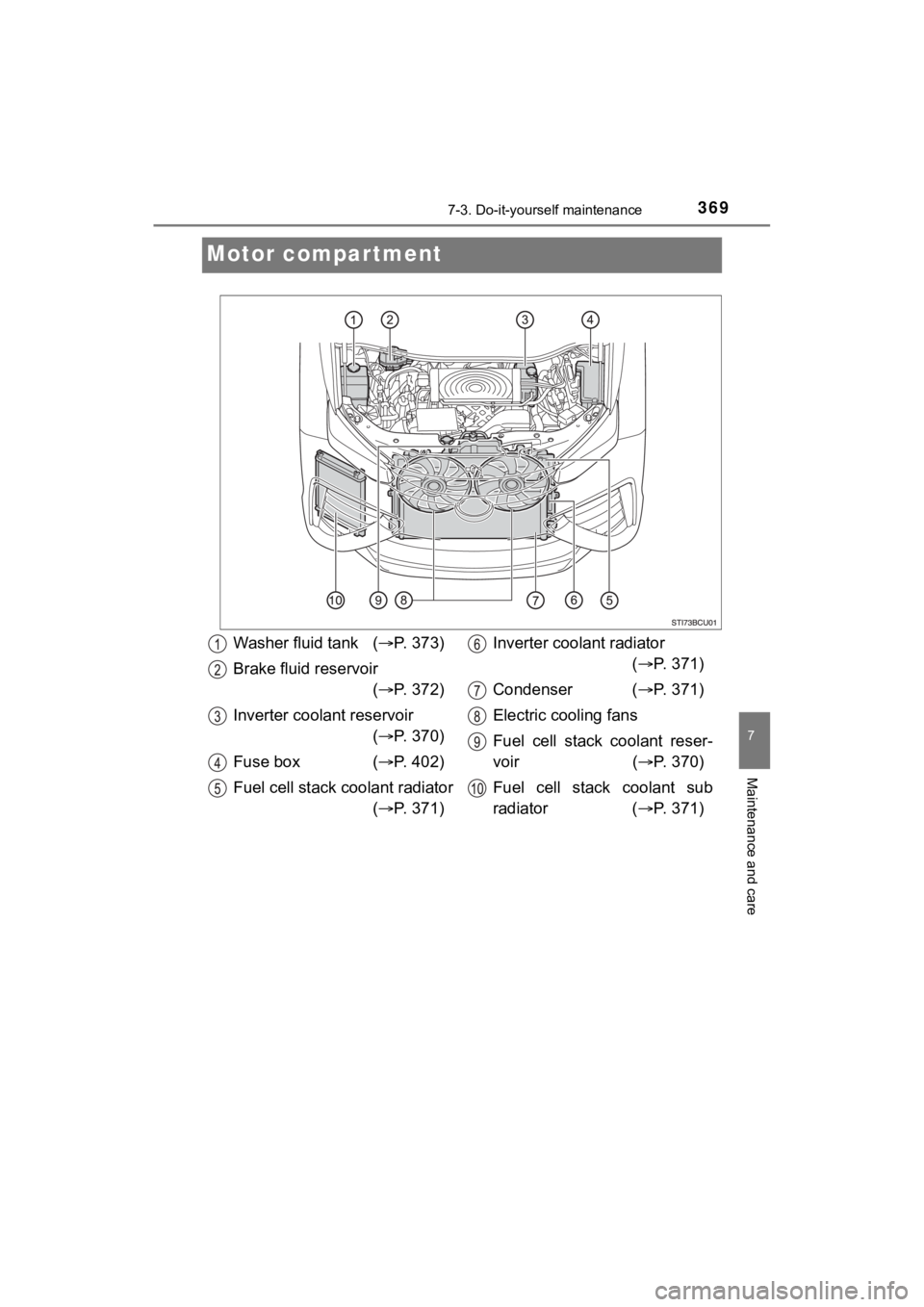
3697-3. Do-it-yourself maintenance
MIRAI_OM_USA_OM62073U
7
Maintenance and care
Motor compartment
Washer fluid tank (P. 373)
Brake fluid reservoir ( P. 372)
Inverter coolant reservoir ( P. 370)
Fuse box ( P. 402)
Fuel cell stack coolant radiator
( P. 371) Inverter coolant radiator
( P. 371)
Condenser ( P. 371)
Electric cooling fans
Fuel cell stack coolant reser-
voir ( P. 370)
Fuel cell stack coolant sub
radiator ( P. 371)
Page 402 of 528
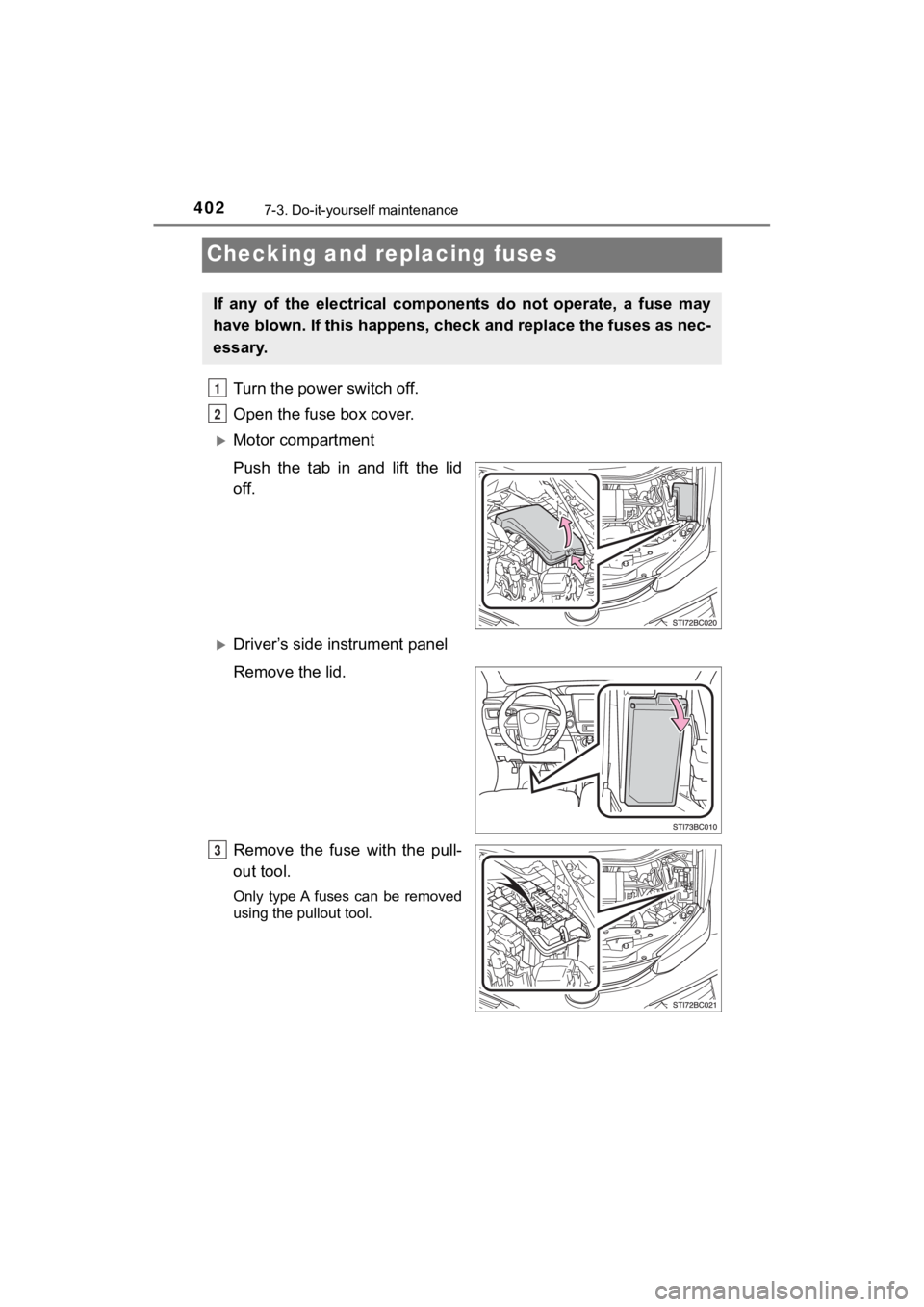
4027-3. Do-it-yourself maintenance
MIRAI_OM_USA_OM62073U
Checking and replacing fuses
Turn the power switch off.
Open the fuse box cover.
Motor compartment
Push the tab in and lift the lid
off.
Driver’s side instrument panel
Remove the lid.
Remove the fuse with the pull-
out tool.
Only type A fuses can be removed
using the pullout tool.
If any of the electrical components do not operate, a fuse may
have blown. If this happens, check and replace the fuses as nec-
essary.
1
2
3
Page 403 of 528
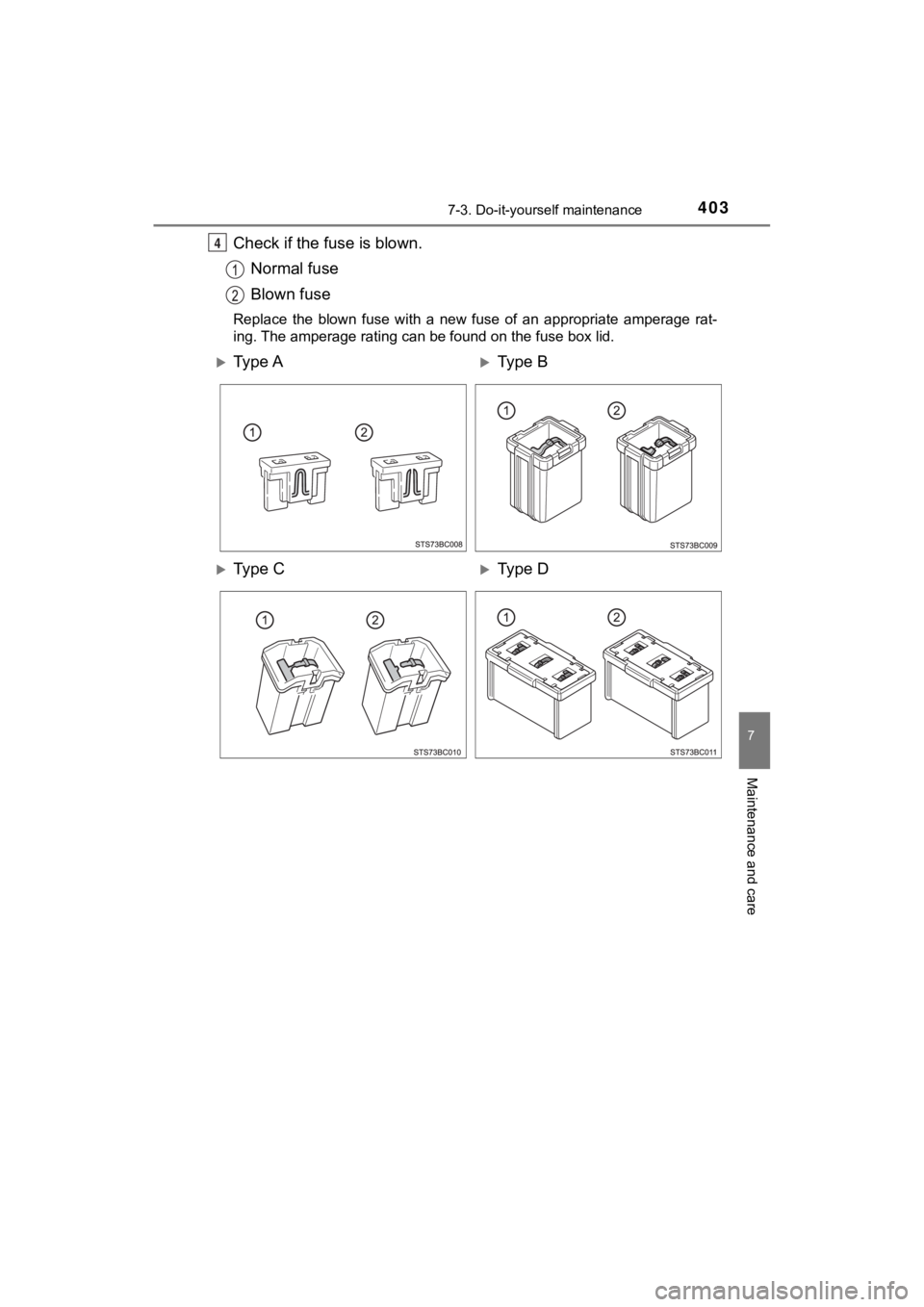
4037-3. Do-it-yourself maintenance
MIRAI_OM_USA_OM62073U
7
Maintenance and care
Check if the fuse is blown.Normal fuse
Blown fuse
Replace the blown fuse with a new fuse of an appropriate ampera ge rat-
ing. The amperage rating can be found on the fuse box lid.
4
Ty p e AType B
Ty p e CType D
Page 404 of 528
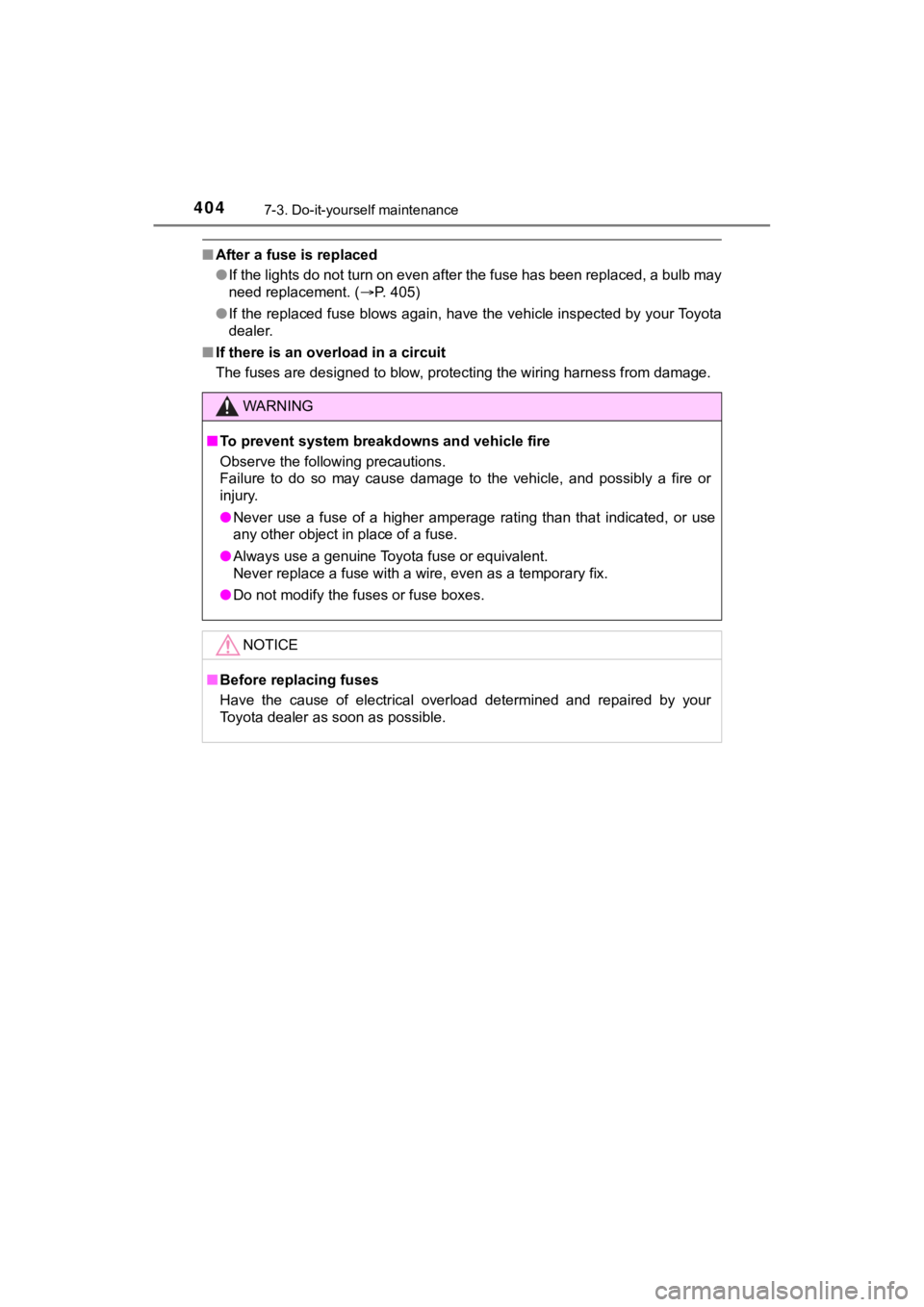
4047-3. Do-it-yourself maintenance
MIRAI_OM_USA_OM62073U
■After a fuse is replaced
●If the lights do not turn on even after the fuse has been repla ced, a bulb may
need replacement. ( P. 405)
● If the replaced fuse blows again, have the vehicle inspected by your Toyota
dealer.
■ If there is an overload in a circuit
The fuses are designed to blow, protecting the wiring harness f rom damage.
WARNING
■To prevent system breakdowns and vehicle fire
Observe the following precautions.
Failure to do so may cause damage to the vehicle, and possibly a fire or
injury.
● Never use a fuse of a higher amperage rating than that indicate d, or use
any other object in place of a fuse.
● Always use a genuine Toyota fuse or equivalent.
Never replace a fuse with a wire, even as a temporary fix.
● Do not modify the fuses or fuse boxes.
NOTICE
■Before replacing fuses
Have the cause of electrical overload determined and repaired b y your
Toyota dealer as soon as possible.
Page 452 of 528
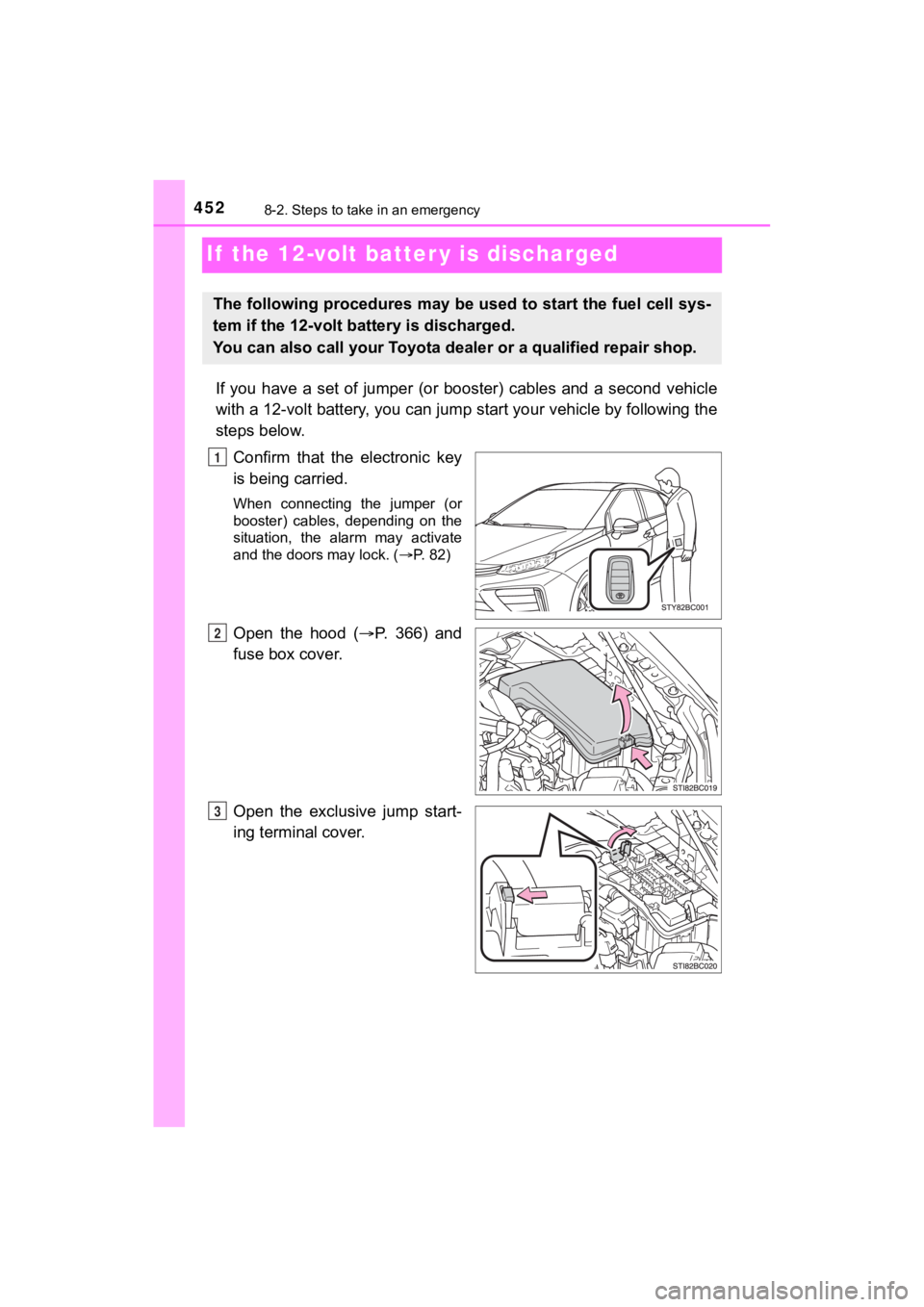
4528-2. Steps to take in an emergency
MIRAI_OM_USA_OM62073U
If the 12-volt batter y is discharged
If you have a set of jumper (or booster) cables and a second vehicle
with a 12-volt battery, you can jump start your vehicle by foll owing the
steps below.
Confirm that the electronic key
is being carried.
When connecting the jumper (or
booster) cables, depending on the
situation, the alarm may activate
and the doors may lock. ( P. 82)
Open the hood (P. 366) and
fuse box cover.
Open the exclusive jump start-
ing terminal cover.
The following procedures may be u sed to start the fuel cell sys-
tem if the 12-volt battery is discharged.
You can also call your Toyota de aler or a qualified repair shop.
1
2
3
Page 454 of 528

4548-2. Steps to take in an emergency
MIRAI_OM_USA_OM62073U
Make sure the “READY” indicator comes on. If the indicator does
not come on, contact your Toyota dealer.
Once the fuel cell system has started, remove the jumper cables in
the exact reverse order from which they were connected.
Close the exclusive jump starting terminal cover, reinstall the motor
cover and the fuse box cover to its original position.
Once the fuel cell system starts, have the vehicle inspected at your
Toyota dealer as soon as possible.
■ Starting the fuel cell system when the 12-volt battery is discharged
The fuel cell system cannot be started by push-starting.
■ To prevent 12-volt battery discharge
●Turn off the headlights and the audio system while the fuel cell system is off.
● Turn off any unnecessary electrical components when the vehicle is running
at a low speed for an extended period, such as in heavy traffic .
■ Charging the 12-volt battery
The electricity stored in the 12-volt battery will discharge gr adually even when
the vehicle is not in use, due to natural discharge and the dra ining effects of
certain electrical appliances. If the vehicle is left for a lon g time, the 12-volt
battery may discharge, and the fuel cell system may be unable to start. (The
12-volt battery recharges automatically while the fuel cell sys tem is operat-
ing.)
■ When the 12-volt battery is removed or discharged
● In some cases, it may not be possible to unlock the doors using the smart
key system when the 12-volt battery is discharged. Use the wire less remote
control or the mechanical key to lock or unlock the doors.
● The fuel cell system may not start on the first attempt after t he 12-volt bat-
tery has recharged but will start normally after the second att empt. This is
not a malfunction.
● The power switch mode is memorized by the vehicle. When the 12- volt bat-
tery is reconnected, the system will return to the mode it was in before the
12-volt battery was discharged. Before disconnecting the 12-volt battery,
turn the power switch off.
If you are unsure what mode the power switch was in before the 12-volt bat-
tery discharged, be especially careful when reconnecting the 12 -volt battery.
● If the 12-volt battery is depleted with the shift position in P , it will not be pos-
sible to shift the shift position other than P. In this case, the vehicle cannot
be towed without lifting both front wheels because the front wheels are
locked by the parking lock. ( P. 412)
8
9
10
Page 518 of 528
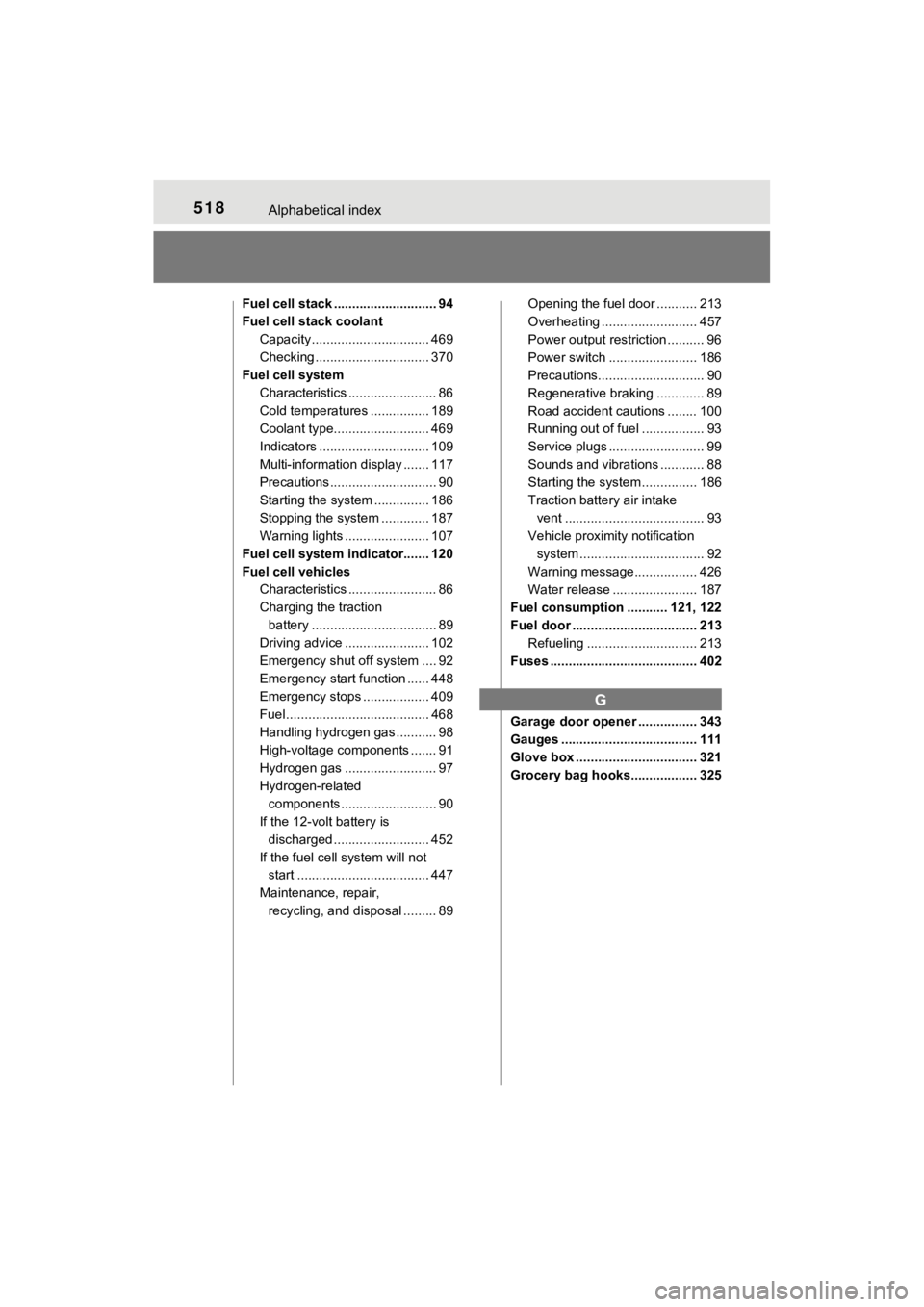
518Alphabetical index
MIRAI_OM_USA_OM62073U
Fuel cell stack ............................ 94
Fuel cell stack coolantCapacity ................................ 469
Checking ............................... 370
Fuel cell system
Characteristics ........................ 86
Cold temperatures ................ 189
Coolant type.......................... 469
Indicators .............................. 109
Multi-information display ....... 117
Precautions ............................. 90
Starting the system ............... 186
Stopping the system ............. 187
Warning lights ....................... 107
Fuel cell system indicator....... 120
Fuel cell vehicles Characteristics ........................ 86
Charging the traction
battery .................................. 89
Driving advice ....................... 102
Emergency shut off system .... 92
Emergency start function ...... 448
Emergency stops .................. 409
Fuel ....................................... 468
Handling hydrogen gas ........... 98
High-voltage components ....... 91
Hydrogen gas ......................... 97
Hydrogen-related
components .......................... 90
If the 12-volt battery is
discharged .......................... 452
If the fuel cell system will not start .................................... 447
Maintenance, repair, recycling, and disposal ......... 89 Opening the fuel door ........... 213
Overheating .......................... 457
Power output restriction .......... 96
Power switch ........................ 186
Precautions............................. 90
Regenerative braking ............. 89
Road accident cautions ........ 100
Running out of fuel ................. 93
Service plugs .......................... 99
Sounds and vibrations ............ 88
Starting the system ............... 186
Traction battery air intake
vent ...................................... 93
Vehicle proximity notification
system .......... ..................... ... 92
Warning message................. 426
Water release ....................... 187
Fuel consumption ........... 121, 122
Fuel door .................................. 213 Refueling .............................. 213
Fuses ........................................ 402
Garage door opener ................ 343
Gauges ..................................... 111
Glove box ................................. 321
Grocery bag hooks.................. 325
G